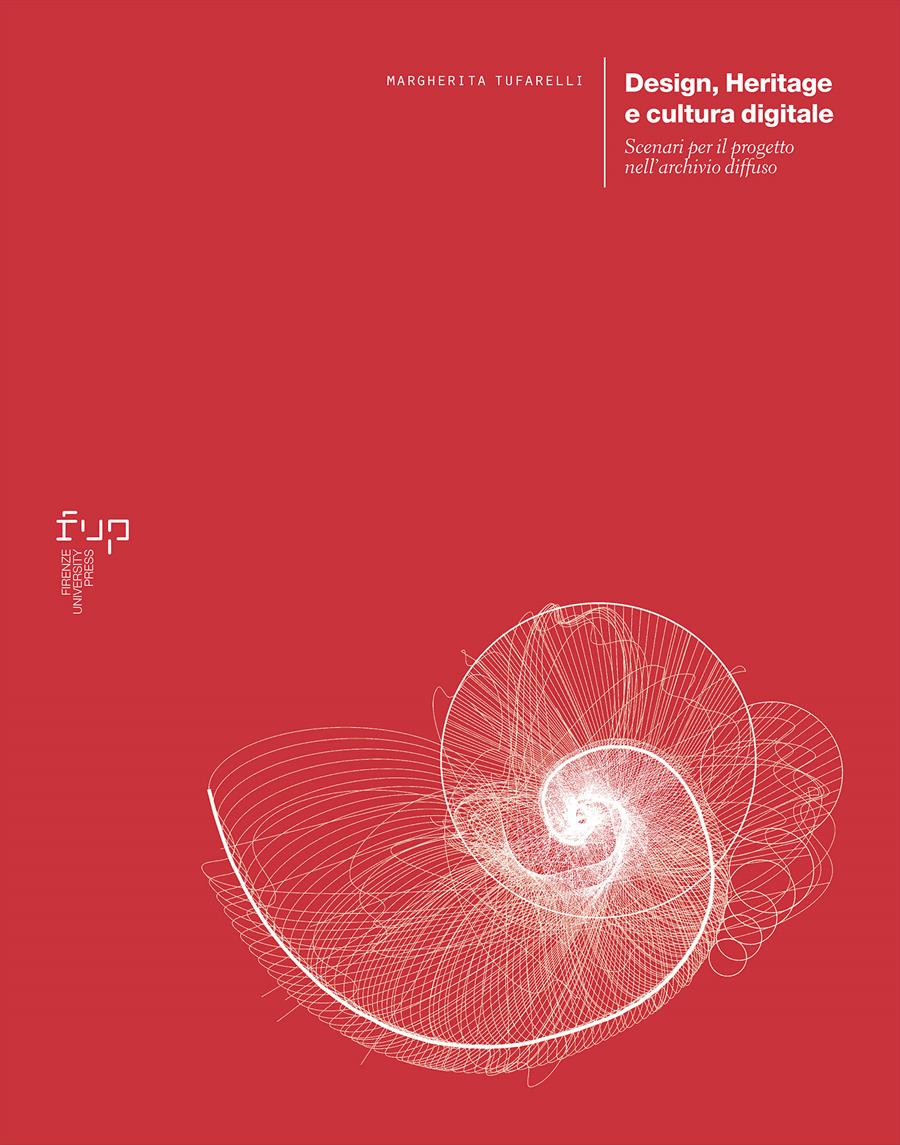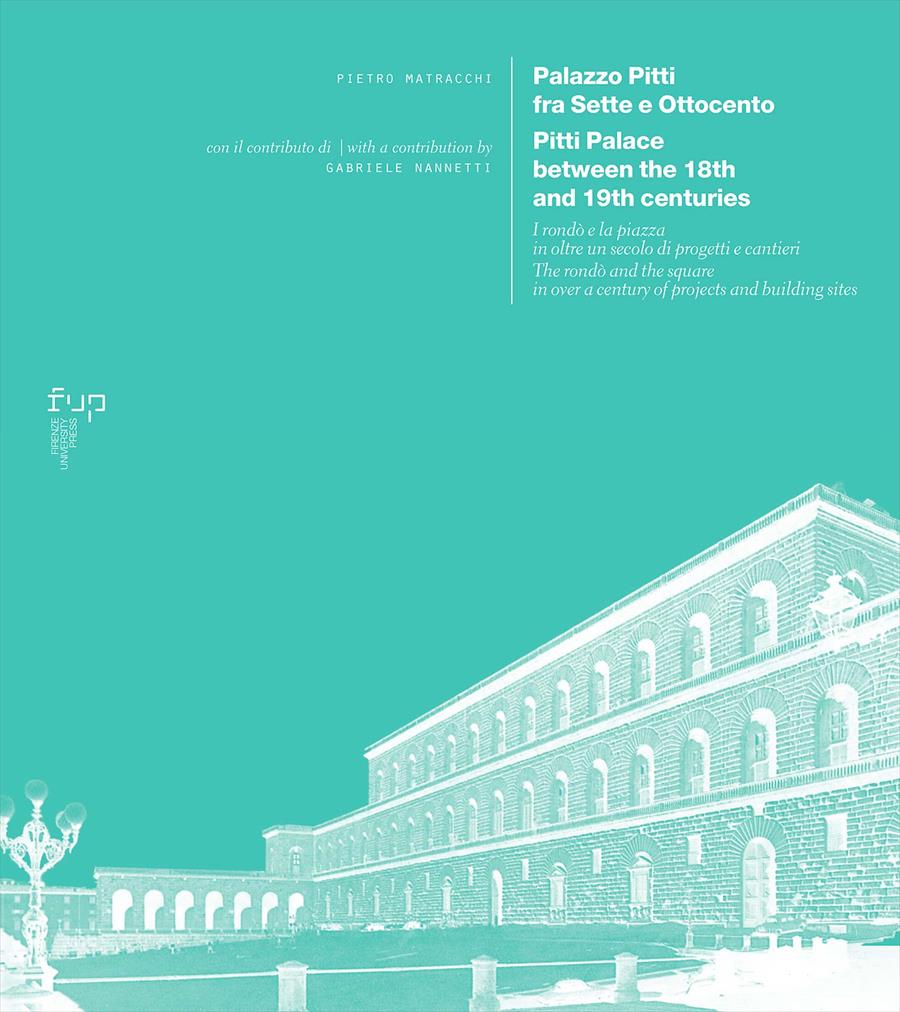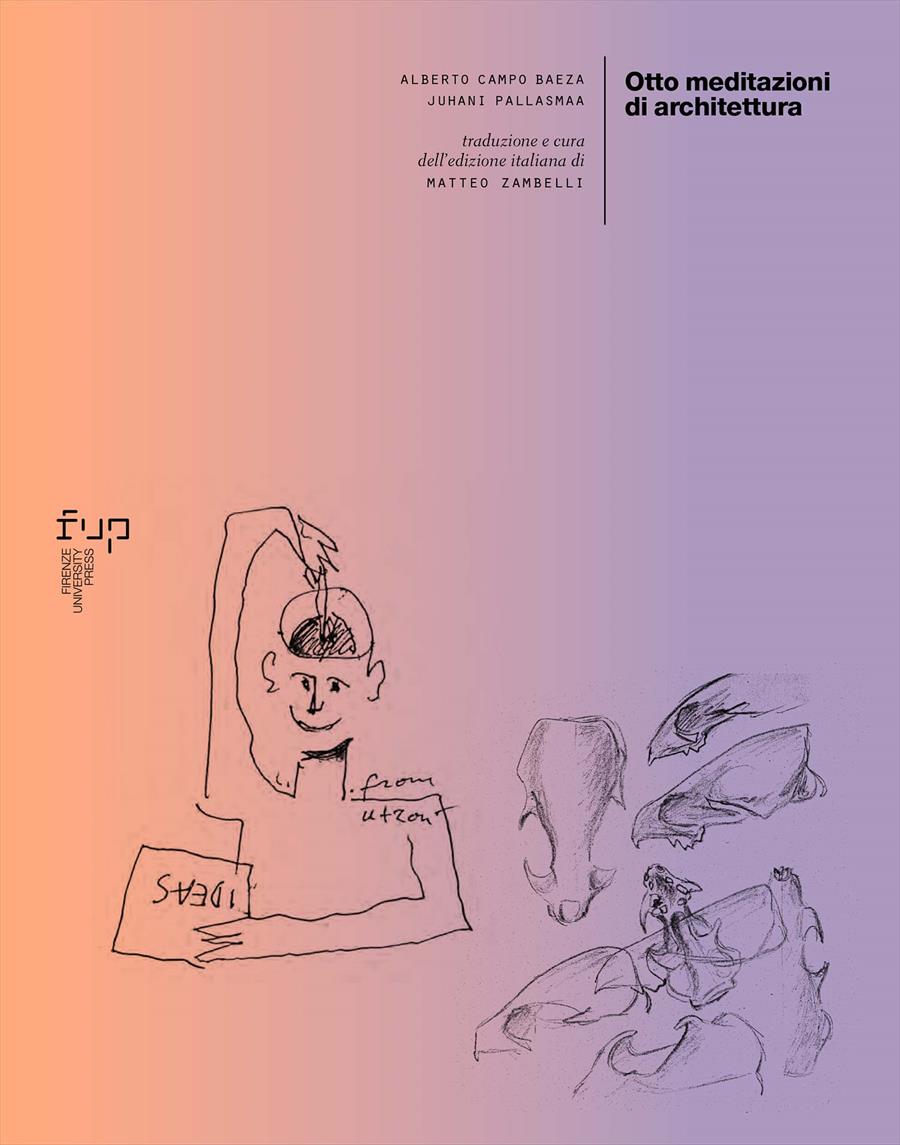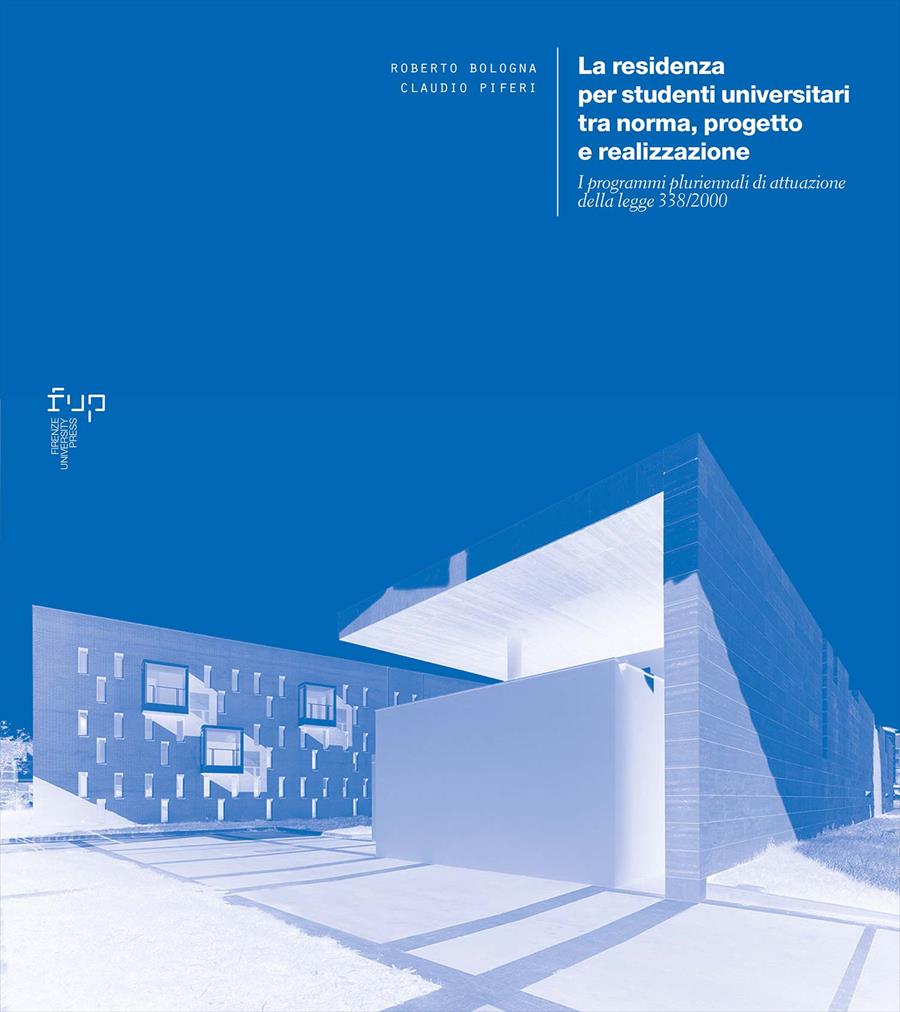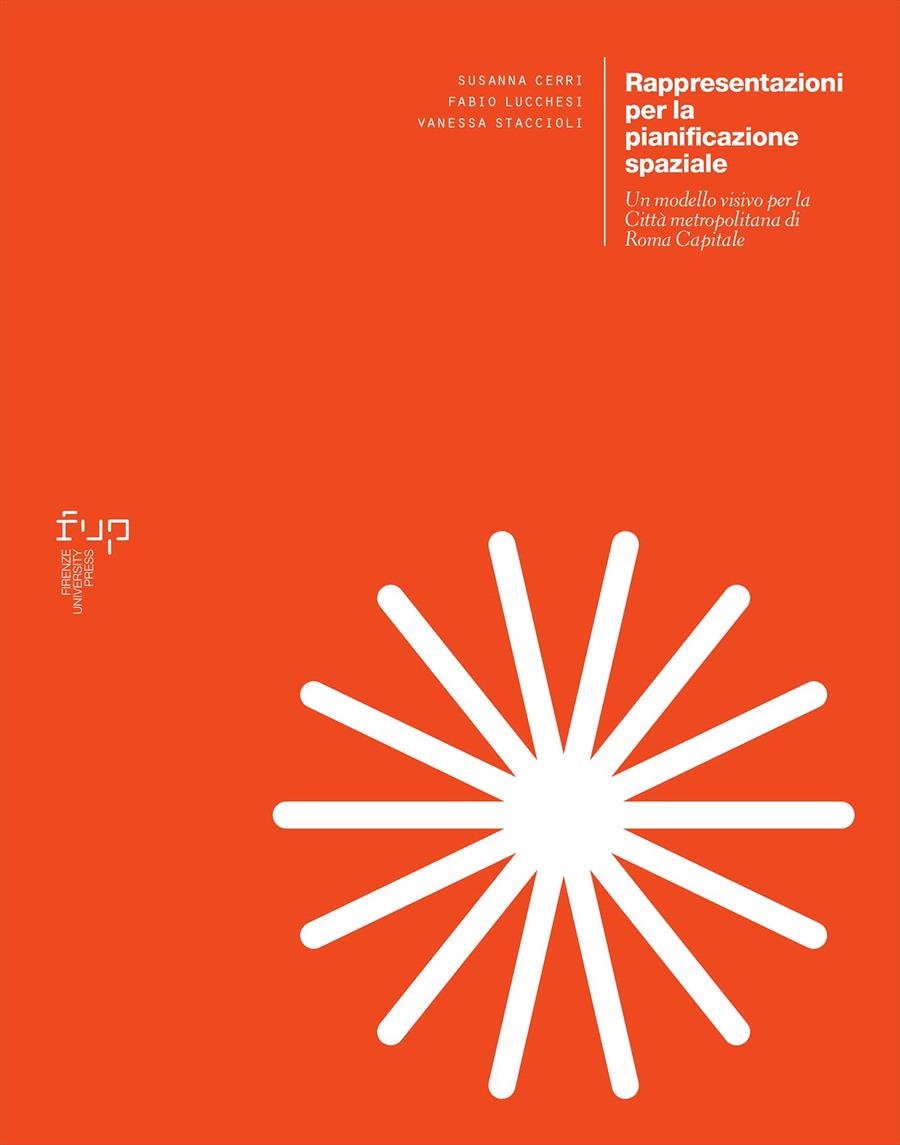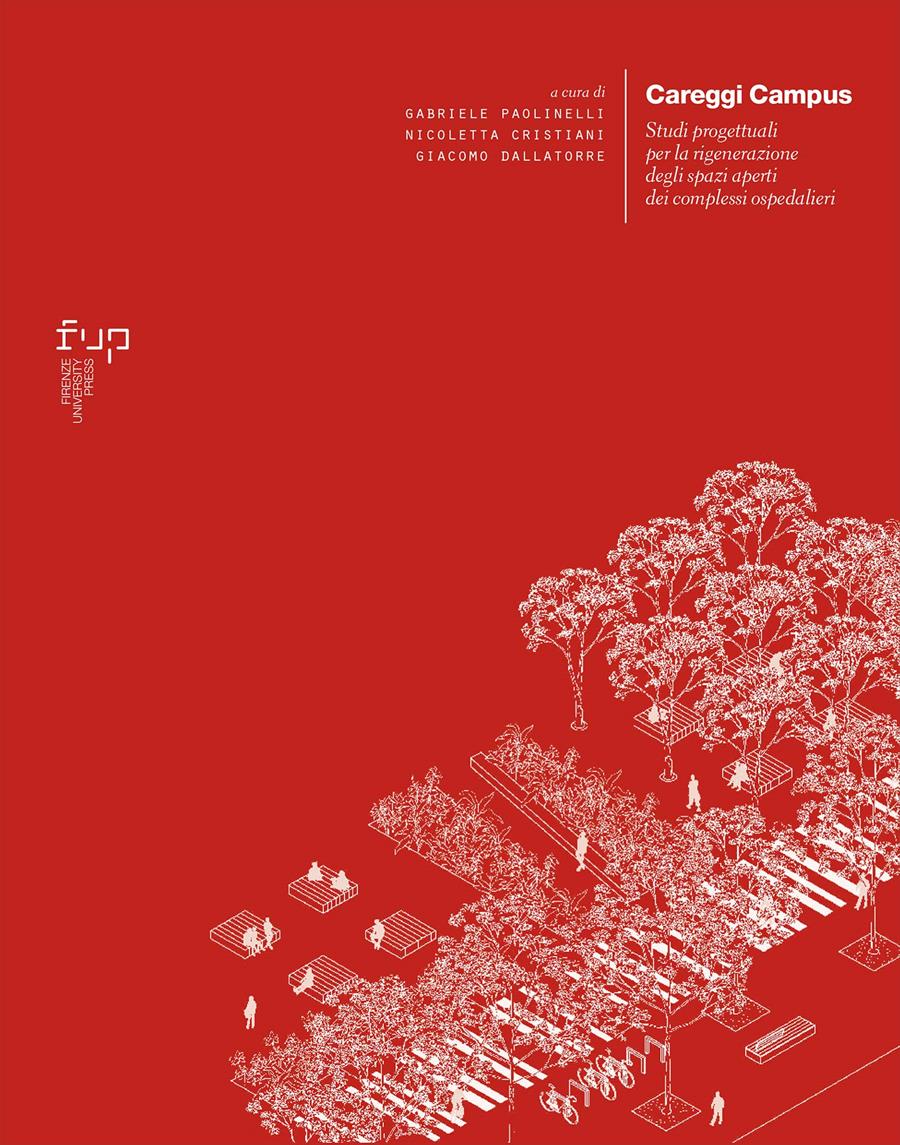Design, Heritage e cultura digitale
Scenari per il progetto nell’archivio diffuso
- Margherita Tufarelli,
With the digital transformation, the exponential increase in the number of tools and types of support with which human expressions can be created and transmitted brings with it new cultural paradigms that feed creative productions and vice versa, giving rise to new questions regarding how Heritage “works”, what it “does” and what it “serves”. This is the general context in which the research project described in this book is set, and the convergence that has been created over time between technologies, cultural heritage, and design, which today seem to implement a triangulation in which each vertex favors the relationship between the other two, opening up new and interesting research perspectives to explore.
- Keywords:
- Design,
- Digital Culture,
- Digital Archives,
- Cultural Heritage,
- Digital Memory,
- DOI: 10.36253/978-88-5518-524-0
- Series: Ricerche. Architettura, Pianificazione, Paesaggio, Design
- Scientific Board
- Language: Italian
- Subjects: Architecture
- Download PDF
-

- © 2022 Author(s)
- CC BY-NC-SA 4.0
University of Florence, Italy - ORCID: 0000-0003-4824-6715
- Accoto, C. (2018). Il mondo dato: cinque brevi lezioni di filosofia digitale. EGEA spa.
- Ackoff, R. L. (1989). From data to wisdom. Journal of applied systems analysis, 16(1), 3-9.
- Almond, K. (2020). Disrupting the Fashion Archive: The Serendipity of Manufacturing Mistakes. Fashion Practice, 12(1), 78-101.
- Amin, A. (2002). Ethnicity and the multicultural city: living with diversity. Environment and planning A, 34(6), 959-980.
- Anderson, S. (2009). Envisioning the archival commons. The American Archivist, 72(2).
- Anheier, H. K., & Isar, Y. R. (Eds.). (2008). Cultures and globalization: The cultural economy. Sage.
- Antonelli, P., Hall, P., Aldersey-Williams, H., & Roberts, R. (2008). Design and the elastic mind. The Museum of Modern Art.
- Arrighetti, A., & Ninni, A. (2014). La trasformazione ‘silenziosa’. Cambiamento strutturale e strategie d’impresa nell’industria italiana. Dipartimento di economia università di Parma, Collana di Economia Industriale e Applicata.
- Ashworth, G. J. (2013). From history to heritage–from heritage to identity. Building a new heritage: Tourism, culture and identity in the new Europe, 13-30.
- Babelon, J., & Chastel, A. (1980). The idea of patrimony.
- Baia Curioni, S. (2005). Imprenditorialità e patrimonio culturale: contributi dalla teoria della social corporate responsibility. In Beni Culturali nel bilancio sociale di impresa. Scuola Normale Superiore di Pisa.
- Bailey, C., Miles, S., & Stark, P. (2004). Culture-led urban regeneration and the revitalisation of identities in Newcastle, Gateshead and the North East of England. International journal of cultural policy, 10(1), 47-65.
- Bakhshi, H., McVittie, E., & Simmie, J. (2008). Creating Innovation: Do the creative industries support innovation in the wider economy?. London: Nesta.
- Bantin, P. C. (1998). Strategies for managing electronic records: a new archival paradigm? An affirmation of our archival traditions?. Archival issues, 17-34.
- Barranha, H. (2018). Derivative narratives: the multiple lives of a masterpiece on the internet. Museum International, 70(1-2), 22-33.
- Bates, M. J. (2005). Information and knowledge: An evolutionary framework for information science. Information Research: an international electronic journal, 10(4), n4.
- Battesti, J. (a cura di). (2012). Que reste-t-il du present ? Collecter le contemporain dans le musees de societe. Bordeaux: Le Festin .
- Battesti, J. (a cura di). (2012). Que reste-t-il du present? Collecter le contemporain dans le musees de societe. Bordeaux: Le Festin.
- Bazerman, C. (2012). The orders of documents, the orders of activity, and the orders of information. Archival Science, 12(4), 377-388.
- Bearman, D. (1991). An indefensible bastion: archives as repositories in the electronic age. Archival management of electronic records, 14-24.
- Bearman, D. (1994). Electronic evidence: strategies for managing records in contemporary organizations (No. 19). Archives & Museums Informatics.
- Bearman, D. (1999). Reality and chimeras in the preservation of electronic records. Corporation for National Research Initiatives.
- Beer, D., & Burrows, R. (2013). Popular culture, digital archives and the new social life of data. Theory, culture & society, 30(4), 47-71.
- Benjamin, W. (1935). L’opera d’arte nell’epoca della sua riproducibilità tecnica. L’opera d’arte nell’epoca della sua riproducibilità tecnica, 1-200.
- Bennett, T., Cameron, F., Dias, N., Dibley, B., Harrison, R., Jacknis, I., & McCarthy, C. (2017). Collecting, ordering, governing: anthropology, museums, and liberal government. Duke University Press.
- Bernstein, J. H. (2009). The data-information-knowledge-wisdom hierarchy and its antithesis.
- Binder, T., & Redström, J. (2006). Exemplary design research.
- Boling, E. (2021). The nature and use of precedent in designing. Design for Learning.
- Bonacini, E. (2018). Partecipazione e co-creazione di valore culturale.# iziTRAVELSicilia ei principi della Convenzione di Faro/Participation and co-creation of cultural value.# iziTRAVELSicilia and the principles of the Faro Convention. IL CAPITALE CULTURALE. Studies on the Value of Cultural Heritage, (17), 227-273.
- Bonsiepe, G. (1995). The chain of innovation science· technology· design. Design Issues, 33-36. Branzi, A., & Seassaro, A. (2003). Verso una modernità debole e diffusa. Poli. Design.
- Bortolotto, C. (2007). From Objects to Processes: UNESCO’S’Intangible Cultural Heritage’. Journal of Museum Ethnography, (19), 21-33.
- Boschma, R. (2005). Rethinking regional innovation policy. In Rethinking regional innovation and change (pp. 249-271). Springer, New York, NY.
- Branzi, A. (2007). L’architettura non è l’arte del costruire. L’architettura è una disciplina molto complessa che interpreta la storia e le tecnologie ei cambiamenti della società. Edizioni Museo Alessi e Corraini.
- Brown, T., & Katz, B. (2011). Change by design. Journal of product innovation management, 28(3), 381-383.
- Broy, M. (Ed.). (2011). Cyber-physical systems: Innovation durch softwareintensive eingebettete Systeme. Springer-Verlag.
- Buendía, F. C. (2010). More carrots than sticks: Antanas Mockus’s civic culture policy in Bogotá. New directions for youth development, 2010(125), 19-32.
- Burdick, A., Drucker, J., Lunenfeld, P., Presner, T., & Schnapp, J. (2012). Digital_ Humanities. Mit Press.
- Burgess, J. (2006). Hearing ordinary voices: Cultural studies, vernacular creativity and digital storytelling. Continuum, 20(2), 201-214.
- Calcagno, M. (2014). Reimagining the design in the middle earth: From design driven innovation to design boosted.
- Caliandro, C., & Sacco, P. L. (2011). Italia reloaded: ripartire con la cultura. Il mulino.
- Carlsson, B., Jacobsson, S., Holmén, M., & Rickne, A. (2002). Innovation systems: analytical and methodological issues. Research policy, 31(2), 233-245.
- Carta di Cracovia (2000). Editorial Marsilio. Roma. ISBN, 88-3178.
- Carta, M. (2002). L’armatura culturale del territorio: il patrimonio culturale come matrice di identità e strumento di sviluppo (Vol. 51). FrancoAngeli.
- Casiello, S. (2008). Autenthicity and Restoration: The Role of the Scuola Napoletana. Autenthicity and Restoration, 1000-1004.
- Castellani, P., & Rossato, C. (2014). On the communication value of the company museum and archives. Journal of Communication Management.
- Castells, M. (1996). 1996: The rise of the network society. Oxford: Blackwell.
- Castells, M. (2006). La nascita della società in rete. EGEA spa.
- Celaschi, F. (2004). La cultura del progetto per il sistema dei beni culturali. Design & Beni culturali. Milano: Edizioni POLI. design, 19-31.
- Celaschi, F. (2017). Advanced design-driven approaches for an Industry 4.0 framework: The human-centred dimension of the digital industrial revolution. Strategic design research journal, 10(2), 97-104.
- Celaschi, F., & Vai, E. (2021). Design Processes in Cultural and Creative Industries’ Oriented Development: A Regional Case. diid—disegno industriale industrial design, (73), 12-12.
- Cianfanelli, E. (2019). Un nuovo orizzonte nella cultura progettuale, Firenze, DIDApress .
- Cianfanelli, E. (2019). Un nuovo orizzonte nella cultura progettuale, Firenze, DIDApress Ciuccarelli, P., & Innocenti, P. (2006). Sistemi conoscitivi per il design: una proposta metodologica.
- Consiglio d’Europa, Convenzione Faro (2005). Convenzione quadro del Consiglio d’Europa sul valore dell’eredità culturale per la società.
- Cook, T. (1994). Electronic records, paper minds: the revolution in information management and archives in the post/custodial and post/modernist era.[Based on a presentation delivered by the author during his November 1993 Australian tour.]. Archives and Manuscripts.
- Cross, N. (1982). Designerly ways of knowing. Design studies, 3(4), 221-227.
- Cross, N. (2001). Designerly ways of knowing: Design discipline versus design science. Design issues, 17(3), 49-55.
- Cross, N. (2011). Design thinking: Understanding how designers think and work. Berg.
- Crutzen, P. J. (2006). The “anthropocene”. In Earth system science in the anthropocene (pp. 13-18). Springer, Berlin, Heidelberg.
- CSES. (2010). Study on the contribution of culture to local and regional development – Evidence from the structural funds, final report. Centre for Strategy and Evaluation Services, Kent.
- Davari, A., Iyer, P., & Guzmán, F. (2017). Determinants of brand resurrection movements: why consumers want dead brands back?. European Journal of Marketing.
- De Lusenet, Y. (2007). Tending the garden or harvesting the fields: Digital preservation and the UNESCO charter on the preservation of the digital heritage. Library Trends, 56(1), 164- 182.
- De Varine, H. (2005). Le radici del futuro: il patrimonio culturale al servizio dello sviluppo locale.
- Del Gobbo, G., Torlone, F., & Galeotti, G. (2018). Le valenze educative del patrimonio culturale. Riflessioni teorico-metodologiche tra ricerca evidence based e azione educativa nei musei.
- Derrida, J. (1995). Archive fever: A Freudian impression. University of Chicago Press.
- Deserti, A., & Rizzo, F. (2014). Design and the Cultures of Enterprises. Design Issues, 30(1), 36-56. Drucker, P. F. (1993). The rise of the knowledge society. The Wilson Quarterly, 17(2), 52-72. Eco, U. (1984). Apocalittici e integrati (Vol. 27). T. Bompiani.
- Deserti, A., & Rizzo, F. (2019). Embedding design in the organizational culture: Challenges and perspectives. Design Culture Objects and Approaches.
- Drysdale, K. (2019). Everyday Archives. In Intimate Investments in Drag King Cultures (pp. 157-184). Palgrave Macmillan, Cham.
- Duffy, S. M., Duffy, A. H. B., & MacCallum, K. J. (1995). A design reuse model.
- Duranti, L. (2001). The impact of digital technology on archival science. Archival science, 1(1), 39-55.
- Edwards, E. (2012). Three. Unblushing Realism Practices of Evidence, Style, and Archive. In The Camera as Historian (pp. 79-122). Duke University Press.
- Eikhof, D. R., & Haunschild, A. (2006). Lifestyle meets market: Bohemian entrepreneurs in creative industries. Creativity and innovation management, 15(3), 234-241.
- Escobar, A. (2012). Notes on the Ontology of Design. Retrieved July, 3, 2014.
- European Commission (2018). Creative Europe Programme 2021-2027 <https://www. consilium.europa.eu/it/policies/creative-europe-2021-2027/>.
- European Commission (2018). New European Agenda for Culture. <https://ec.europa.eu/culture/document/new-european-agenda-culture-swd2018-267-final>.
- Evans, G. (2009). Creative cities, creative spaces and urban policy. Urban studies, 46(5-6), 1003-1040.
- Fabre, D. (2013). Il duro desiderio di durare. Parolechiave, 21(1), 31-52.
- Fabris, G. (2005). Il consumo come esperienza. Il consumo come esperienza, 1000-1006.
- Fallan, K. (2013). De-tooling Design History: To What Purpose and for Whom Do We Write?. Design and Culture, 5(1), 13-19.
- Fallan, K. (2019). Design culturing. Making design history matter. In Julier, G., Folkmann, M. N., Skou, N. P., Jensen, H. C., & Munch, A. V. (Eds.). (2019). Design Culture: objects and approaches. Bloomsbury Publishing.
- Ferraris, M. (2021). Documanità: Filosofia del mondo nuovo. Gius. Laterza & Figli Spa.
- Fionda, A. M., & Moore, C. M. (2009). The anatomy of the luxury fashion brand. Journal of brand Management, 16(5), 347-363.
- Flew, T. (2002). Beyond ad hocery: defining creative industries. In Cultural Sites, Cultural Theory, Cultural Policy, The Second International Conference on Cultural Policy Research.
- Flew, T., & Cunningham, S. (2013). Creative industries after the first decade of debate. In Creative industries and urban development (pp. 76-86). Routledge.
- Følstad, A., Kvale, K., & Halvorsrud, R. (2013). SINTEF Customer journey measures-State of the art research and best practices.
- Foster, H. (2003). Design and crime: and other diatribes. Verso.
- Foster, H. (2004). An archival impulse. October, (110), 3-22.
- Friedman, K. (2002). Towards an integrative design discipline. Creating breakthrough ideas: the collaboration of anthropologists and designers in the product development industry, 200- 214.
- Frosio, G. (2021). The Origins and History of Remix in Creative Culture. THE HANDBOOK OF REMIX STUDIES AND DIGITAL HUMANITIES (Eduardo Navas, Owen Gallagher and Xtine Burrough eds., Routledge, forthcoming 2021).
- Fry, T. (2009). Design futuring. University of New South Wales Press, Sydney, 71-77.
- Fry, T. (2014). The Origin of the Work of Design: Thoughts based on a Reading of Martin Heidegger’s “The Origin of the Work of Art”. Design Philosophy Papers, 12(1), 11-22.
- Gere, C. (2009). Digital culture. Reaktion Books.
- Germak, C., Bistagnino, L., & Celaschi, F. (2008). Uomo al centro del progetto–Design per un nuovo umanesimo| Man at the Centre of the Project–Design for a New Humanism. Umberto Allemandi & C., Torino.
- Giannachi, G. (2016). Archive Everything: mapping the everyday. Mit Press.
- Gibbons, L. (2014). Culture in the continuum: YouTube, small stories and memory-making. Monash University Faculty of Information Technology Caulfield School of Information Technology.
- Gibbons, L. (2016). Exploring social complexity: Continuum Theory and a research design model for archival research. Research in the Archival Multiverse, 762-788.
- Gilliland, A. J., & McKemmish, S. (2004). Building an infrastructure for archival research. Archival science, 4(3-4), 149-197.
- Gilliland, A. J., & McKemmish, S. (2006). Archival Science: International Journal on Recorded Information.
- Gilliland, A. J., Lau, A. J., & McKemmish, S. (2021). Pluralizing the archive. In Archives for Maintaining Community and Society in the Digital Age (pp. 61-70). Springer, Singapore.
- Gilliland, A. J., McKemmish, S., White, K., Lu, Y., & Lau, A. (2008). Pluralizing the archival paradigm: Can archival education in pacific rim communities address the challenge?. The American Archivist, 71(1), 87-117.
- Godfrey, P. C., Hassard, J., O’Connor, E. S., Rowlinson, M., & Ruef, M. (2016). What is organizational history? Toward a creative synthesis of history and organization studies. Academy of Management Review, 41(4), 590–608.
- Goretti, G. (2018). Maestri Avanzata Advanced Craftsmanship–percorso di ricerca nella manifattura moda Toscana. Aracne.
- Goretti, G., Cianfanelli, E., & Tufarelli, M. (2018) Digital Archive as a Creative Booster. Connecting Design Processes to Logistics and PLM Platforms.
- Goretti, G., Cianfanelli, E., Baccolini, R., Aiello, R. (2015) RED4MART: Reverse Engineering for Manufacturing Digital Archive to Enhance Advanced Craftsmanship Know- How and High-End Manufacturing Traceability.
- Gradmann, S. (2010). Knowledge= Informatio in Conyext: on the Importance of Semantic Contextualisation. In Europeana White Paper, Location: Leuven (Vol. 1, pp. 1-19). Berlin School of Library und Information/Humboldt Universitat zu Berlin; europena think culture.
- Grossi, E., Blessi, G. T., Sacco, P. L., & Buscema, M. (2012). The interaction between culture, health and psychological well-being: Data mining from the Italian culture and well- being project. Journal of Happiness Studies, 13(1), 129-148.
- Grossi, E., Sacco, P. L., Blessi, G. T., & Cerutti, R. (2011). The impact of culture on the individual subjective well-being of the Italian population: an exploratory study. Applied research in quality of life, 6(4), 387-410.
- Gruenfeld, E. (2010). Thinking creatively is thinking critically. New directions for youth development, 2010(125), 71-83.
- Gunn, W., Otto, T., & Smith, R. C. (Eds.). (2013). Design anthropology: theory and practice. Taylor & Francis.
- Hakala, U., Lätti, S., & Sandberg, B. (2011). Operationalising brand heritage and cultural heritage. Journal of Product & Brand Management.
- Halbwachs, M. (1992). On collective memory. University of Chicago Press.
- Harrison, R. (2010). What is heritage. Understanding the politics of heritage, 9.
- Harrison, R. (2013). Forgetting to remember, remembering to forget: late modern heritage practices, sustainability and the ‘crisis’ of accumulation of the past. International Journal of Heritage Studies, 19(6), 579-595.
- Harrison, R. (2020). Heritage futures: comparative approaches to natural and cultural heritage practices. UCL press.
- Harrison, R., Bartolini, N., DeSilvey, C., Holtorf, C., Lyons, A., Macdonald, S., Penrose, S. (2016). Heritage futures. Archaeology International, 19, 68-72.
- Hedstrom, M. (1997). Digital preservation: a time bomb for digital libraries. Computers and the Humanities, 31(3), 189-202.
- Highmore, B. (2009). The design culture reader. London.
- Hilbert, M., & López, P. (2011). The world’s technological capacity to store, communicate, and compute information. science, 332(6025), 60-65.
- Holling, H. B. (2015). Archival Turn. RIXC and Liepaja’s University Art Research Lab. Ketelaar, E. (2001). Archives in the digital age: new uses for an old science. Archivaria, 52, 1-25.
- Hollinger, D.M. (2006). Instrument of social reform: A case study of the Venezuelan system of youth orchestras. PhD dissertation, Arizona State University.
- Holt, M. (2016). Baudrillard and the Bauhaus: The Political Economy of Design. Design Issues, 32(3), 55-66.
- Huang, S., Carulli, M., Hekkert, P., Schifferstein, R. N. J., & Bordegoni, M. (2020). Designing product metaphor to promote sustainable behaviour: A proposed method. In Proceedings of the Design Society: DESIGN Conference (Vol. 1, pp. 1921-1930). Cambridge University Press.
- Icomos (2002). International Cultural Tourism Charter. Principles And Guidelines For Managing Tourism At Places Of Cultural And Heritage Significance. ICOMOS International Cultural Tourism Committee.
- Ingold, T., & Hallam, E. (2021). Creativity and cultural improvisation: An introduction (pp. 1-24). Routledge.
- Irace, F. (2013a). Digitalization takes command. Design & Cultural Heritage. Vol 3, Immateriale, virtuale, interattivo. Electa.
- Irace, F. (2013b). L’Archivio animato. In Irace, F., & Ciagà, G. L. (2013). Design & Cultural Heritage. Vol 2, Archivio animato. Electa.
- Irvine, M. (2014). Remix and the dialogic engine of culture: A model for generative combinatoriality. In The Routledge companion to remix studies (pp. 39-66). Routledge.
- Jagodzinska, K., Sanetra-Szeliga, J., Purchla, J., Van Balen, K., Thys, C., Vandesande, A., & Van der Auwera, S. (2015). Cultural Heritage Counts for Europe: full report.
- Julier, G. (2006). From visual culture to design culture. Design issues, 22(1), 64-76.
- Julier, G. (2013). The culture of design. Sage.
- Julier, G., Folkmann, M. N., Skou, N. P., Jensen, H. C., & Munch, A. V. (Eds.). (2020). Design Culture: objects and approaches. Bloomsbury Publishing.
- Kalay, Y., Kvan, T., & Affleck, J. (Eds.). (2007). New heritage: New media and cultural heritage. Routledge.
- KEA & PPMI (2019), Research for CULT Committee – Culture and creative sectors in the European Union- key future developments, challenges and opportunities, European Parliament, Policy Department for Structural and Cohesion Policies, Brussels.
- KEA European Affairs. (2006). The Economy of culture in Europe: A study prepared for the European Commission (Directorate-General for Education and Culture). EC.
- KEA European Affairs. (2021). The Economy of culture in Europe: A study prepared for the European Commission (Directorate-General for Education and Culture). EC.
- Kendall, S. (2014). Positioning Design Studies: An Institutional Challenge. Design and Culture.
- Konlaan, B. B., Bygren, L. O., & Johansson, S. E. (2000). Visiting the cinema, concerts, museums or art exhibitions as determinant of survival: a Swedish fourteen-year cohort follow-up. Scandinavian journal of public health, 28(3), 174-178.
- Krippendorff, K. (1989). On the essential contexts of artifacts or on the proposition that” design is making sense (of things)”. Design issues, 5(2), 9-39.
- Krippendorff, K. (2005). The semantic turn: A new foundation for design. crc Press.
- Kroeze, R., & Keulen, S. (2013). Leading a multinational is history in practice: The use of invented traditions and narratives at AkzoNobel, Shell, Philips and ABN AMRO. Business History, 55(8), 1265–1287.
- Kubler, G., Previtali, G., & Casatello, G. (1976). La forma del tempo: considerazioni sulla storia delle cose. Einaudi.
- Kuny, T. (1998). The digital dark ages? Challenges in the preservation of electronic information. International preservation news, 17, 8-13.
- Latour, B. (1987). Science in action: How to follow scientists and engineers through society. Harvard university press.
- Latour, B. (2005). Reassembling the social: an introduction to actor-network-theory. Oxford University Press, Oxford.
- Lee, J. S. (2002). The Korean language in America: The role of cultural identity in heritage language learning. Language culture and curriculum, 15(2), 117-133.
- Lessig, L. (2008). Remix. Bloomsbury Academic.
- Lindley, S. E., Marshall, C. C., Banks, R., Sellen, A., & Regan, T. (2013). Rethinking the web as a personal archive. In Proceedings of the 22nd international conference on World Wide Web (pp. 749-760).
- Lowenthal, D. (1996). Possessed by the past: The heritage crusade and the spoils of history.
- Lupo, E. (2008). Progettare luoghi, territori, contesti. Una esperienza formativa e progettuale di meta-brand del territorio.
- Lupo, E. (2014). Beyond social innovation: design as cultures active-action. In A matter of design. Making society through sciences and technology. 5° STS Italia Conference (pp. 137-154). STS Italia Publishing.
- Lupo, E. (2019a). Design e Cultural driven innovation. i+ Diseño. Revista científico-académica internacional de innovación, investigación y desarrollo en Diseño, 14, 120-132.
- Lupo, E. (2019b). Forme del craft, forme del progetto. Oltre le retoriche: per una innovazio- ne Cultural driven.
- Madon, S., Jussim, L., Keiper, S., Eccles, J., Smith, A., & Palumbo, P. (1998). The accuracy and power of sex, social class, and ethnic stereotypes: A naturalistic study in person perception. Personality and Social Psychology Bulletin, 24(12), 1304-1318.
- Maldonado, T. (1971). La speranza progettuale. Feltrinelli Editore.
- Maldonado, T. (2003)[1961]. Disegno industriale: un riesame (Vol. 142). Feltrinelli Editore.
- Manning, J. (2017). Unusable archives: Everyday play and the everyplay archives. In Fans and Videogames (pp. 197-212). Routledge.
- Manzini, E. (2015). Design, when everybody designs: An introduction to design for social innovation. MIT press.
- Manzini, E. (2019). Politics of the Everyday (Designing in Dark Times).
- Margolin, V. (2015). World history of design (Vol. 2). Bloomsbury Publishing.
- Martino, C. (2012). Design: verso una riscoperta della cultura materiale. Op cit: selezione della critica d’arte contemporanea, (143), 27.
- Martins, L. L., Rindova, V. P., & Greenbaum, B. E. (2015). Unlocking the hidden value of concepts: A cognitive approach to business model innovation. Strategic Entrepreneurship Journal, 9(1), 99-117.
- Mason, M. (2008). The Pirate’s Dilemna, How Youth Culture is Reinventing Capitalism. The Free Press.
- Mason, M. & Vavoula, G., (2021) Digital Cultural Heritage Design Practice: A Conceptual Framework, The Design Journal, 24:3, 405-424.
- Matarasso, F. (2006). La storia sfigurata: la creazione del patrimonio culturale nell’Europa contemporanea. S. Bodo and MR Cifarelli, eds, 50-62.
- McCann, A., Early, J., Horowitz, A., Kurin, R., Prosterman, L., Seeger, A., & Seite, P. (2001). The 1989 Recommendation Ten Years On: Toward a Critical Analysis, 57-61. Accessed online at https://folklife.si.edu/resources/unesco/mccann.htm
- McElroy, M. W. (2002). Social innovation capital. Journal of intellectual capital.
- McKemmish, S. (1997). Today, Today and Tomorrow: A Continuum of Responsibility. Proceedings of the Records management Association of Australia, 14.
- McKemmish, S., & Piggott, M. (2013). Toward the archival multiverse: challenging the binary opposition of the personal and corporate archive in modern archival theory and practice. Archivaria, 111-114.
- McKemmish, S., Piggott, M., Reed, B., & Upward, F. (2005). Archives: recordkeeping in society. Elsevier.
- McKemmish, S., Upward, F. H., & Reed, B. (2010). Records continuum model. Encyclopedia of library and information sciences.
- Melchior, M. R., & Svensson, B. (Eds.). (2014). Fashion and museums: theory and practice. A&C Black.
- Micelli, S., & Rullani, E. (2014). Idee motrici, intelligenza personale, spazio metropolitano: tre proposte per il nuovo Made in Italy nell’economia globale di oggi. Sinergie Italian Journal of Management, (84), 127-156.
- Montella, M. (2009). Valore e valorizzazione del patrimonio culturale storico. Milano, Italy: Electa.
- Montella, M., Petraroia, P., Manacorda, D., & di Macco, M. (2016). La Convenzione di Faro e la tradizione culturale italiana/The Faro Convention and the Italian cultural tradition. IL CAPITALE CULTURALE. Studies on the Value of Cultural Heritage, 13-36.
- Morley, J., & McMahon, K. (2011). Innovation, interaction, and inclusion: heritage luxury brands in collusion with the consumer. In Fashion & Luxury: Between Heritage & Innovation: the 13th Annual Conference for the International Foundation of Fashion Technology Institutes.
- Mosca, F. (2017). Heritage di prodotto e di marca. Modelli teorici e strumenti operative di marketing per le imprese nei mercati globali del lusso.
- Negri, M. (2016). La grande rivoluzione dei musei europei: Museum Proms. Marsilio.
- O’Carroll, C. (2015). Digital pathways: Questions of digital curation for archives of everyday experience. Béaloideas, 34-52.
- Otto, T., & Smith, R. C. (2020). Design anthropology: A distinct style of knowing. In Design Anthropology (pp. 1-29). Routledge.
- Oxman, R. (1990). Prior knowledge in design: a dynamic knowledge-based model of design and creativity. Design studies, 11(1), 17-28.
- Oxman, R. (2006). Theory and design in the first digital age. Design studies, 27(3), 229-265.
- Paraventi, M., & Cataldo, L. (2007). Il museo oggi: linee guida per una museologia contemporanea. Il museo oggi, 1-320.
- Parente, M., Lupo, E., & Sedini, C. (2017). Tangibile/Intangibile. Dialoghi sul Design per i Territori 02.
- Penati, A. (2013). È il design una narrazione?: design e narrazioni. È il design una narrazione?, 1-106.
- Pistilli, O. K. (2018). The Heritage-Creativity Interplay. How fashion designers are reinventing heritage as modern design: the French case. ZoneModa Journal, 8(1), 77-95.
- Plaza, B. (2008). On some challenges and conditions for the Guggenheim Museum Bilbao to be an effective economic reactivator. International Journal of Urban and Regional Research, 32(2), 506-517.
- Poli, D. (2015). Il patrimonio territoriale fra capitale e risorsa nei processi di patrimonializzazione proattiva. Aree interne e progetti d’area, 123-140.
- Poulot, D. (2006). De la raison patrimoniale aux mondes du patrimoine. Socio-anthropologie, (19).
- Pratt, A. C. (2009). Policy transfer and the field of the cultural and creative industries: What can be learned from Europe?. In Creative economies, creative cities (pp. 9-23). Springer, Dordrecht.
- Riccini, R. (2017a). Il design, opera aperta. Arte e arti del Bel Paese. In Collina, C. (2017). ER/DESIGNEstetica del quotidiano negli istituti culturali dell’Emilia-Romagna.
- Riccini, R. (2020) What“knowledge”isdesign? , diid N°70/20 Design 2030: Knowledge.
- Riccini, R. (Eds.). (2017b). Fare Ricerca In Design. Forum nazionale dei dottorati di ricerca in design seconda edizione. Il Poligrafo.
- Rifkin, J. (2000). The age of access: how the shift from ownership to access is transforming modern life (p. 30). London: Penguin.
- Riviezzo, A., Garofano, A., & Napolitano, M. R. (2016). “Il tempo è lo specchio dell’eternità”. Strategie e strumenti di heritage marketing nelle imprese longeve italiane/“Il tempo è lo specchio dell’eternità”(Time is the mirror of eternity). Heritage marketing strategies and tools In Italian long-lived firms. IL CAPITALE CULTURALE. Studies on the Value of Cultural Heritage, (13), 497-523.
- Rothenberg, J. (1999). Avoiding Technological Quicksand: Finding a Viable Technical Foundation for Digital Preservation. A Report to the Council on Library and Information Resources. Council on Library and Information Resources, 1755 Massachusetts Ave., NW, Washington, DC 20036.
- Rullani, E. (2008). Lavoro immateriale e società della conoscenza. PARADIGMI. Sacco, P. L., & Teti, E. (2017). Cultura 3.0: un nuovo paradigma di creazione del valore. Economia & Management, 1(2017), 79-96.
- Saffer, D. (2005). The role of metaphor in interaction design. Information Architecture Summit, 6.
- Salarelli, A. (2014a). Diritto all’oblio e archivi online dei quotidiani: alcune considerazioni sulla memoria sociale ai nostri tempi. JLIS. it: Italian Journal of Library, Archives and Information Science. Rivista italiana di biblioteconomia, archivistica e scienza dell’informazione, 5(1), 1-20.
- Salarelli, A. (2014b). Sul perché, anche nel mondo dei Linked Data, non possiamo rinunciare al concetto di documento. AIB studi, 54(2/3).
- Sanderhoff, M. (2013). Open Images. Risk or opportunity for art collections in the digital age?. Nordisk museologi, (2), 131-131.
- Sanders, E. B. N., & Stappers, P. (2013). Convivial Toolbox: generative design research for the fuzzy front end.
- Sanders, E. B. N., & Stappers, P. J. (2008). Co-creation and the new landscapes of design. Co-design, 4(1), 5-18.
- Santagata, W. (2009). Libro bianco sulla creatività: per un modello italiano di sviluppo. EGEA. Segre, S. (2005). La moda: un’introduzione. GLF Ed. Laterza.
- Santagata, W. (2014). Il governo della cultura: promuovere sviluppo e qualità sociale. Il mulino.
- Schellenberg, T. R. (1998). The management of archives.
- Schmidt, L., Nave, J. G., & Guerra, J. (2006). Who’s afraid of Local Agenda 21? Top-down and bottom-up perspectives on local sustainability. International Journal of Environment and Sustainable Development, 5(2), 181-198.
- Schnapp, J. (2013). Archivio animato. In Irace, F., & Ciagà, G. L. (2013). Design & Cultural.
- Schön, D. A. (1979). Generative metaphor: A perspective on problem-setting in social policy. Metaphor and thought, 254, 283.
- Schön, D. A. (1987). Educating the reflective practitioner: Toward a new design for teaching and learning in the professions. Jossey-Bass.
- Schön, D. A. (Ed.). (1991). The reflective turn: Case studies in and on educational practice (Vol. 131). New York: Teachers College Press.
- Scott, A. J. (2006). Entrepreneurship, innovation and industrial development: geography and the creative field revisited. Small business economics, 26(1), 1-24.
- Sennett, R. (2008). The craftsman. Yale University Press.
- Settis, S. (2004). Futuro del” classico”. G. Einaudi.
- Simon, H. A. (1969). The sciences of the artificial. MIT press.
- Simon, N. (2010). The participatory museum. Museum 2.0.
- Smith, L. (2006). Uses of heritage. Routledge.
- Smith, R. C., & Otto, T. (2020). Cultures of the future: Emergence and intervention in design anthropology. In Design anthropological futures (pp. 19-36). Routledge.
- Sonkoly, G., Vahtikari, T. (2018). Innovation in Cultural Heritage research. For An integrated European research policy. Brussels: European Commission Directorate-General for Research and Innovation.
- Spampinato, D. (2018). AIUCD2018-Book of Abstracts.
- Stevens, S. S. (1946). On the theory of scales of measurement.
- Stig, D. C. (2015). Technology platforms: Organizing and assessing technological knowledge to support its reuse in new applications. Chalmers Tekniska Hogskola (Sweden).
- Suddaby, R., Foster, W. M., & Trank, C. Q. (2010). Rhetorical history as a source of competitive advantage. In J. A. C. Baum & J. Lampel (Eds.), Globalization of strategy research (Vol. 27, pp. 147–173). London: Emerald.
- Swidler, A. (1986). Culture in action: Symbols and strategies. American sociological review, 273-286.
- Symbola, I. Q. (2020). Io sono Cultura 2020. L’Italia della qualità e della bellezza sfida la crisi. Throsby, D. (2008). The concentric circles model of the cultural industries. Cultural trends, 17(3), 147-164.
- Throsby, D. (2006). An artistic production function: Theory and an application to Australian visual artists. Journal of Cultural Economics, 30(1), 1-14.
- Tonkinwise, C. (2019). Research For Designing After Ownership. In Integrative Design (pp. 44-56). Birkhäuser.
- UNESCO (1994) Information Note: Nara Document on Authenticity. Experts meeting, (1– 6 November) World Heritage Committee – Eighteenth Session, (12–17 December 1994). WHC-94/CONF.003/INF.008. Disponibile a <http://whc. unesco.org/archive/nara94.htm>.
- Urde, M., Greyser, S. A., & Balmer, J. M. (2007). Corporate brands with a heritage. Journal of Brand Management, 15(1), 4-19.
- Vacca, F. (2014). Knowledge in memory: Corporate and museum archives. Fashion Practice, 6(2), 273-288.
- Valéry, P. (1926). La conquête de l’ubiquité (p. 4). J.-M. Tremblay.
- Van den Boomen, M. V. (2014). Transcoding the digital: how metaphors matter in new media. Institute of Network Cultures.
- Van Dijk, J. (2020). The network society. Sage.
- Van Lent, W., & Smith, A. D. (2019). Perceiving the Present by Means of the Past: Theorizing the Strategic Importance of Corporate Archives. In Strategic Responsiveness and Adaptive Organizations: New Research Frontiers in International Strategic Management. Emerald Publishing Limited.
- Vecco, M. (2007). L’evoluzione del concetto di patrimonio culturale (Vol. 153). FrancoAngeli.
- Venice Charter (1964). International charter for the conservation and restoration of monuments and sites. Venice, Italy.
- Wang, H. H., & Liao, W. J. (2009). Applications of metaphor theory to product design. Proceedings of International Association of Societies of Design Research.
- Washington, D. M., & Beecher, D. G. (2010). Music as social medicine: Two perspectives on the West Eastern Divan Orchestra. New directions for youth development, 2010(125), 127-140.
- Webster, F. (2014). Theories of the information society. Routledge.
- Wiedmann, K. P., Hennigs, N., Schmidt, S., & Wuestefeld, T. (2011). Drivers and outcomes of brand heritage: consumers’ perception of heritage brands in the automotive industry. Journal of Marketing Theory and Practice, 19(2), 205-220.
- Publication Year: 2022
- Pages: 146
- eISBN: 978-88-5518-524-0
- Content License: CC BY-NC-SA 4.0
- © 2022 Author(s)
- Publication Year: 2022
- eISBN: 978-88-5518-525-7
- Content License: CC BY-NC-SA 4.0
- © 2022 Author(s)
Bibliographic Information
Book Title
Design, Heritage e cultura digitale
Book Subtitle
Scenari per il progetto nell’archivio diffuso
Authors
Margherita Tufarelli
Peer Reviewed
Publication Year
2022
Copyright Information
© 2022 Author(s)
Content License
Metadata License
Publisher Name
Firenze University Press
DOI
10.36253/978-88-5518-524-0
eISBN (pdf)
978-88-5518-524-0
eISBN (xml)
978-88-5518-525-7
Series Title
Ricerche. Architettura, Pianificazione, Paesaggio, Design
Series ISSN
2975-0342
Series E-ISSN
2975-0350
